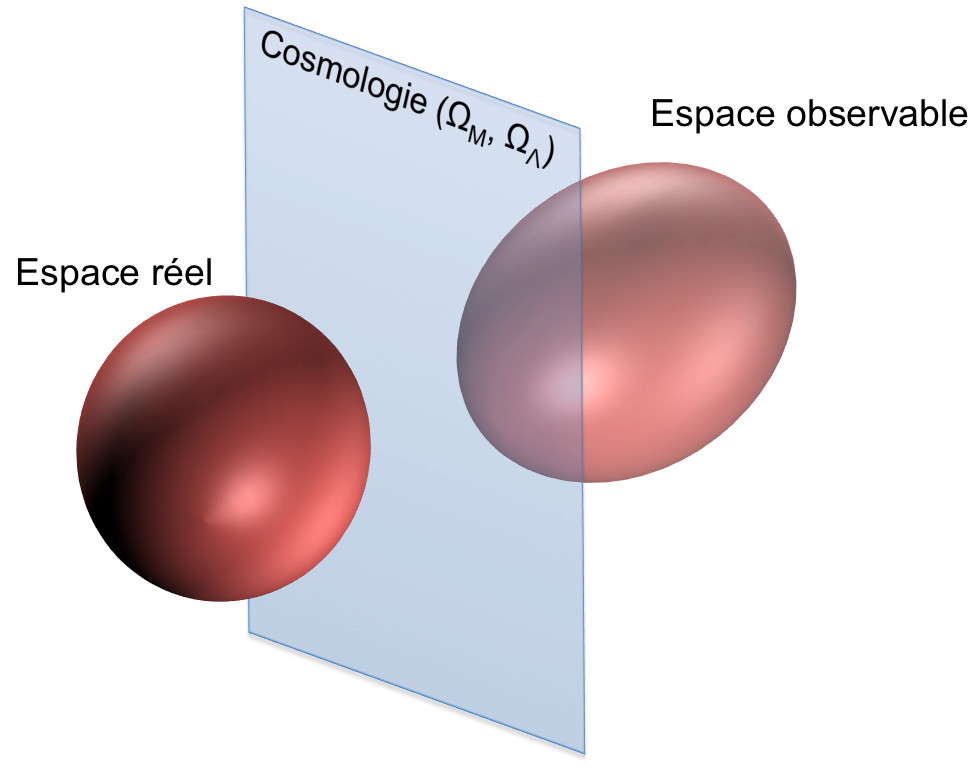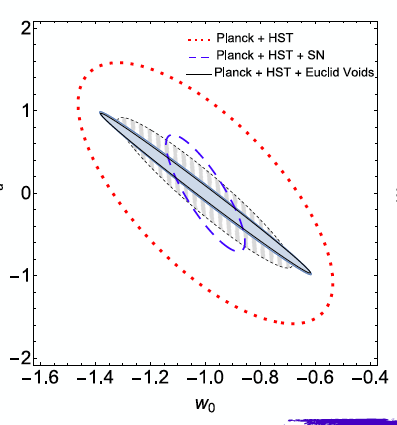

To determine the energy content of the Universe and measure its cosmic history, an observational method is to use Baryonic Acoustic Oscillations (BAO) as a standard scale in the spatial distribution of galaxies. Indeed, the pressure waves propagated in the photon-baryon plasma at the time of the primordial Universe just before recombination (about 380,000 years after the Big Bang) have left an imprint in the radiation corresponding to the Anisotropies observed in the Cosmological Diffuse Background (CMB), and an imprint in the material, corresponding to a privileged distance between two galaxies of about 105 h -1 mpc. The measurement of this characteristic distance at different redshifts makes it possible to constrain the history of the evolution of the Universe and thus the properties of the black energy. Anticipated in the 1970s as a CMB effect, the first detections of the BAO peak were in 2005 with the Sloan Digital Sky Survey (SDSS) (Eisenstein et al., 2005).
One of the challenges of the BAO is the small amplitude of the signal, requiring the enumeration of huge cosmic volumes in order to obtain an accurate distance measurement. The BOSS survey for Baryon Oscillation Spectroscopic Survey (Dawson et al., 2013) of SDSS-III (2009-2014) was part of this new generation of spectroscopic galaxy surveys, proposing to map the three-dimensional distribution of 1.5 million Of bright red galaxies (LRG) between 0.2 The eBOSS project, for extended-BOSS (Dawson et al., 2016), succeeded BOSS in 2014. The goal of eBOSS, planned for 6 years until 2019, is to cover the whole area in intermediate redshift. That is 0.6 The BOSS and eBOSS collaborations are made up of 150 scientists, mainly American, with a French participation grouping IN2P3, INSU and CEA. The MPPM joined BOSS in 2010, and has been part of eBOSS since 2014. BOSS operates the 2.5-meter wide field of view telescope of the Sloan Foundation, located at the Apache Point Observatory in New Mexico (USA). Since 2010, the group has been involved in the study of galaxies with emission lines (ELG) in order to anticipate the future soundings of distant galaxies which must cover the almost unexplored redshifts z> 0.8 range. In the framework of BOSS, the galaxies used are the bright red galaxies (LRG) which represent a very homogeneous population of older galaxies, typically located at redshifts z <0.8. In order to probe the Universe more deeply, one possibility is to use the blue galaxies located beyond z = 0.8. These young galaxies, which have a high rate of star formation, exhibit strong emission lines in their spectra, including the doublet [OII], which makes it possible to measure their redshift. The work of our group, in collaboration with the Laboratory of Astrophysics of Marseille (LAM), concerned the validation of the color selection based on photometric bands u, g, r, i by studying the success rates of measurement of these Objects with large redshift. Simulated spectrum of an ELG galaxy located at a redshift of z = 0.5, on which a reconstruction is applied in order to deduce the measured redshift. Finally, these studies were a precursor to the BOSS collaboration, and helped to establish the eBOSS proposal. The eBOSS project was accepted by After-Sloan 3 in November 2011 and started in July 2014. We also participated in the SEQUELS pilot program for eBOSS. In order to improve our understanding of the nature of black energy, we also participated in the application of a new promising cosmological test, the Alcock-Paczynski (AP) test (Alcock et al., 1979). The principle of the AP test is to consider a perfect spherical system in real space, based on the assumption of the uniformity and isotropy of the universe on a large scale. When these objects are observed in the redshifts space, the measure of their apparent size depends on the fiducial cosmology. Thus any deviation with respect to 1 from the ratio of the radial size to the transverse size of the object makes it possible to constrain the cosmological parameters. The Alcock-Paczynski test makes it possible to constrain the cosmology of the Universe by measuring the deformation in the observable space of a spherical or symmetrical object in real space. We received support from the ANR through the OMEGA Young Researchers project (2011-2015), whose motivation was to study the application of the AP test on a symmetrical set composed of pairs of galaxies, supposed to have no preferential orientation Average "in a homogeneous and isotropic Universe. We have applied the AP test to the pairs of galaxies close to the BOSS survey (Gonzalez-Perez et al., 2013), which amounts to studying the average anisotropy of galaxy pairs (AAP test of Marinoni et al. . We also study how to apply the AP test to cosmic voids. Indeed, the enormous amount of data available today by major polls of galaxies, such as BOSS and eBOSS of SDSS in which the group participates, has revived the interest of voids for cosmology just recently. In particular cosmic voids, which fill most of the Universe, contain very little matter, and could be composed mainly of black energy. These regions therefore present themselves as an ideal laboratory for testing black energy scenarios and forcing cosmic expansion. The idea is to apply the AP test on cosmic voids, using the recent work of Lavaux et al., Who introduced the idea of extracting cosmological information from stacked cosmic voids. The stacking of the voids makes it possible to mean their shape and to soften the contours, and to carry out statistical tests on average, exactly as in the test of the pairs of galaxies. And as in a homogeneous and isotropic Universe there is no reason why voids, on average, should have a privileged direction, the voids are, on average, spherical, and seem to be well adapted to the Alcock-Paczynski test. Constraints in the plane (w0, wa) indicating the improvement on the DE by the addition of the voids (Pisani 2015). One way of constraining possible deviations between the observations and the predictions of General Relativity is also to combine different cosmological probes. In order to be closer to the analyzes that make it possible to constrain models of modified gravity as an interpretation of the cosmic acceleration of the Universe, we have started a collaboration with the LAM to carry out clustering-lensing combination studies. This probe combination analysis is applied to a region of the sky identified by both the BOSS (spectroscopic survey for clustering) survey and the CFHTLenS program (photometric survey for gravitational shear studies). In this work, we studied at the MPPM a new approach for estimating the covariance matrix. Indeed, a crucial step in the clustering of galaxies is to obtain an unbiased estimate of the covariance matrix, which is done by simulated catalogs, representative of the data and sensitive to internal modeling. To achieve the precision required, thousands of realizations are necessary, which becomes prohibitive in CPU. At CPPM we proposed a realization alternative, based on a jackknife method. The idea is to generate a large number of pseudo-realizations from a single simulated catalog realization, and to derive an estimate of the covariance matrix. Since this variance remains dependent on the initial simulation, which is moreover desirable, the operation is repeated for other initial realizations (all independent), and then the covariance matrices are averaged. It can be shown that the number of initial prints can thus be reduced by a factor of seven with the jackknife resampling, obtaining the same estimate of the covariance for the same expected precision.Scientific activities
Emission line galaxies

The Alcock-Paczynski test

The cosmic voids

Cross-correlation study of galaxy clustering and weak lensing